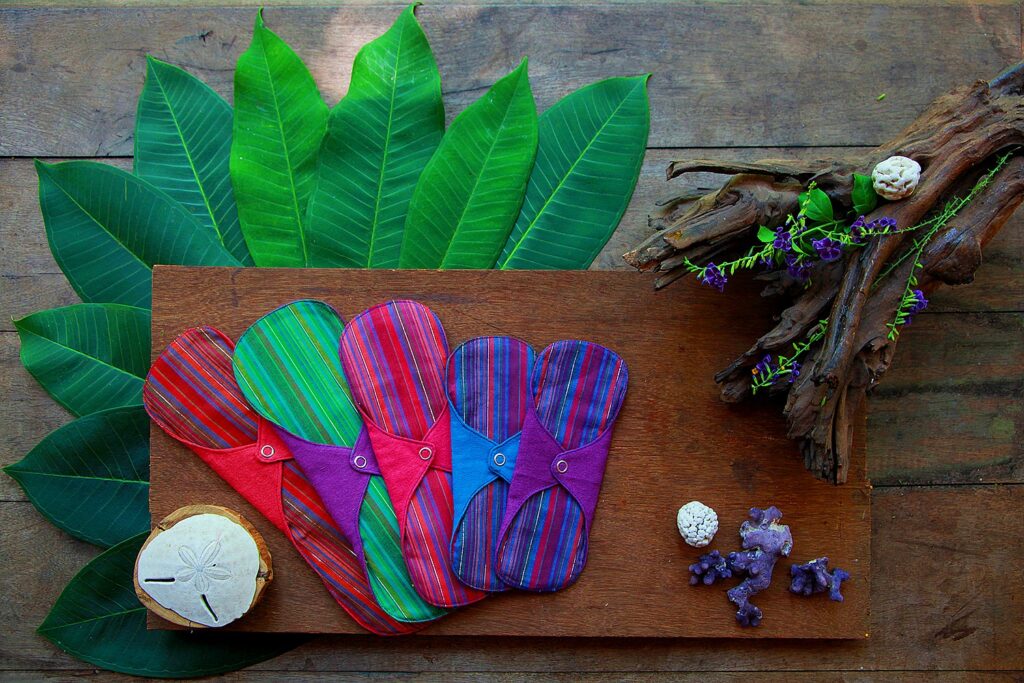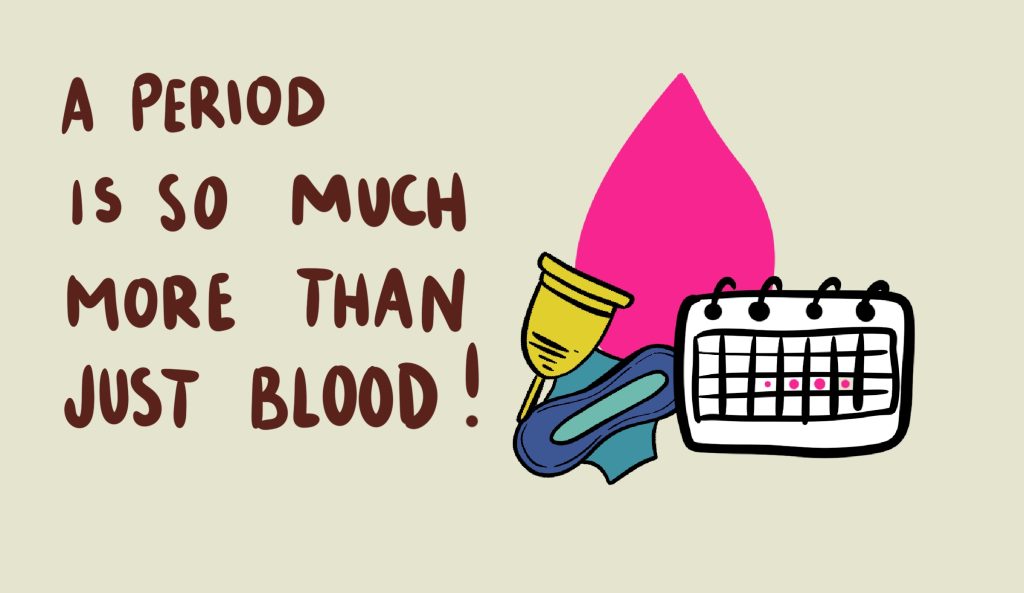While there are ailments which do require the assistance of health professionals, there are many good habits that can bring comfort during menstruation which apply to all phases of the menstrual cycle. Stress, poor diet, lack of sleep and an irregular lifestyle can easily affect well-being during menstruation. Here are are some simple self help hacks on emotional wellness, diet and exercise to be good with yourself.

Self Care Tip #1: Get to know yourself
As you learn Embracing Menstruation, it is important to know Your menstrual cycle has 4 phases, pre-ovulation, before your body releases an egg, ovulation, when the egg is released, pre-menstruation, as your body prepares to shed the lining of the uterus and menstruation when you bleed. Each phase brings new emotional and physical changes which, when we are in tune with them, can be easier to manage. Before getting into the details of exercises or thinking about changes to your diet, you can ask yourself, “how do I feel?”. Overwork, stress, lack of sleep, lack of time and space for yourself, disregard of your needs and being unaware our own inner “rhythm” of life, might disconnect us from feeling what is good for our self.
“Taking care of our personal self is not a luxury but an essential need just as food and water!”
Here are a few ways in which you can get to know yourself:
Meditation
It’s not always easy to find time for yourself during a busy day. But meditation is a great way to to connect with yourself, your body and it’s monthly changes. Even just a few minutes a day can dramatically boost your mood and emotional wellness. You can see a series of videos for meditation during the menstrual cycle here.
Know your Cycle
Get to know your own cycle. You can do this by taking daily notes, recognising shifts in mood, thoughts, stress and physical changes (you can download and print the Eco Femme’s cycle tracking chart for free here). Another easy way to track your cycle is to use a period tracking app on your smartphone. Many of the Eco Femme team members use this one, but there are a growing number of apps available to suit different needs – you can see a selection of them in these blog articles- How to track your Menstrual cycle and Guide to Period Tracking Apps.
Know your Body
Did you know that your cervical mucus changes during your cycle depending on your level of fertility? This is a great way to learn about the monthly changes taking place within your body. Here’s a useful article showing photos of the different kinds of mucus and when they are likely to be present in your cycle. Your body temperature also changes during your cycle. By taking your basal body temperature (BBT, your temperature upon waking) you can determine where you are in your cycle. This is often practiced as part of natural contraception, either to plan or to avoid pregnancy. This article explains more on BBT charting.
Know your Emotions
It’s become a bit of a stereotype that women get emotional during their menstrual cycle, especially in the days before menstruation (commonly known as pre-menstrual tension/ syndrome or PMT/ PMS). There are a number of hormonal changes throughout the menstrual cycle which can drastically affect your moods! The biggest culprit is estrogen. Beginning at puberty, a woman’s ovaries start releasing estrogen in coordination with each monthly menstrual cycle. At mid-cycle, levels suddenly spike, triggering the release of an egg (ovulation). They then fall just as quickly. During the rest of the month, estrogen levels climb and fall gradually. These fluctuations can trigger changes in mood ranging from irritability and tearfulness to rage and depression.
Knowing your cycle and emotions will help you and those around you to better accept and deal with these feelings, there is nothing wrong with feeling this way! Talking with your female family members or close friends can be a big help, after all I’m sure they can sympathise!
Adjust the rhythm of your lifestyle to your cycle – Adjust yourself to your-self! Celebrate your ebbing and flowing body and all that comes with it. If you know when your period is coming, you can better prepare by taking a relaxing bath or taking some time to yourself, you can accept the changes in mood by being gentle with yourself or requesting the understanding of those around you.
“Our cycles are a sign of our connection to humanity, the planet and all life. This is something to be honoured and seen as a blessing rather than a curse.”
Self Care Tip #2: Have a regular and healthy exercise practice
Doing exercise is great for keeping yourself fit and healthy in general. Your fitness program during the whole month will have a good effect on your time of menstruation, as do specific exercises that you can do during your menstruation. Exercise not only tones your muscles and gives you a good stamina, but also moves around and massages your internal organs, which keeps them healthy and flexible, preventing adhesions. You will benefit from increased flow of blood and lymph fluids throughout your body, which will distribute nutrients and hormones adequately and flush out waste and toxins from your body. It can also be beneficial against PMT/ PMS complaints. Below are some recommended practices.
Fresh Air
The oxygen exchange during exercise done in the open air is beneficial. Read more here.
Yoga
Yoga is a great exercise which can be adapted to all levels of fitness. It can benefit your mind as well as your body throughout the month although there are some poses which should be avoided during your period. We made a video showing some particularly useful yoga positions to ease cramps during menstruation. Watch here.
The Aviva Method
Aviva Steiner developed this 30 minute sequence of 18 exercises specifically for women. Pelvic muscle condition, blood and lymph flow around the reproductive organs and thus exchange of hormones, nutrients, oxygen are stimulated. The beneficial effects for the menstrual cycle, fertility, pregnancy and menopause have been researched for 50 years. The program can offer help for painful, long, irregular or absent menstrual periods, unexplained infertility, hormonal weight problems, uterine fibroids, PCOS (Polycystic Ovarian Syndrome), urinary infections, uterine malposition, adhesions of the reproductive organs, PMS (premenstrual syndrome) and menopause difficulties. This exercise sequence is learnt with an instructor, to ensure it is correctly implemented in detail. Visit this site or read our blog for more info on the Aviva Method in India.
Breathing exercises
Healthy breathing not only supplies your body with oxygen through the lungs. The up and down movement of the diaphragm also rhythmically moves around blood and lymph fluids and massages your abdominal and pelvic organs. When you inhale, the diaphragm pushes down, expelling blood and lymph from the abdomen like when you press a sponge, and when you breathe out it rises and organs move back up with it. While this happens during your usual breathing all the time, you can do special exercises to deepen your breathing or release specific tensions during your menstruation. This can relieve tummy cramps and back pains by assisting your bowel movements and stimulating the flow of any static fluids, as well as help with your blood pressure if you have a tendency to faint during your time of menstruation or even just feel weak and sluggish.
Try this: On an empty stomach, lay on your back with your legs bent, breath in and out deeply 2 times, then breath out completely and with this empty breath (don’t breathe in!) pull in and push out your tummy several times slowly and rhythmically until you have to catch your breath, relax a minute and repeat 5 times. You will realize how it becomes easier the more often you do it, best not only during your period but during your full cycle.
Self Care Tip #3: Let Food be your Medicine
Your everyday diet throughout your life can have a big impact on your physical and mental health. But it can be particularly important to pay attention to what you eat and drink during your periods as certain foods can really benefit you during this time. It’s common to crave sugary and fatty foods in the days before your period as serotonin (the feel good hormone) dips at this time caused by a spike in a hormone called cortisol but it is best to not give in to these cravings if possible as fatty and sugary food are not good for your health. Below we share some good foods to eat during menstruation.
Recommended foods
Proteins like dal, tofu, whole nuts, paneer, eggs and lean meats are recommended as they keep your blood sugar levels in check as well as keeping you feeling fuller for longer and limiting or reducing your sugar cravings. Carbohydrates such as whole-grains, cereals, oatmeal and wholemeal flours work in a similar way to proteins by keeping you feeling full and reducing sugar cravings. Foods rich in calcium like milk or curd could help sooth pain from PMS as well as acting as a relaxant. If you have a dairy free diet, you could choose non dairy sources of calcium. Citrus fruits such as lemon, orange or sweet lime contain vitamin C which is beneficial. Bananas are rich in potassium which boosts mood, aids sleep and keeps bowel movements regular.
It is crucial that foods rich in iron are consumed as this stops the risk of aenemia which is caused when blood is lost. Meats are highest in iron but there are a number of other sources of iron that do not come from animals. Be sure to combine your iron rich foods with foods containing vitamin C as it can aid the absorption of iron into the body. Omega 3 fatty acid: it is thought that women who received a daily dose of 6 gm of fish oil suffered from fewer PMS symptoms than those who didn’t consume the same. Apart from fish, flaxseeds and pumpkin seeds are also rich in omega 3 fatty acids that can help you get relief from cramps and pains.
Recommended drinks
The very best thing to drink is water, it can alleviate bloating and keep you well hydrated. Caffeine free herbal teas are also good as they can relax and sooth you.
Best to Avoid
Avoiding certain foods leading up to and during your period may help alleviate discomfort from PMT. Restricting your consumption of foods and beverages that contain caffeine can help relieve menstrual symptoms. Caffeine-containing foods and beverages, such as chocolate, coffee, tea and soft drinks, can worsen symptoms such as anxiety, depression and breast tenderness. Keeping salt intake under control can help you avoid bloating and the puffy, heavy feeling that comes with it.
Avoiding processed foods is one of the best ways to control salt consumption because processed foods and convenience foods are typically packed with sodium. High-fat foods can have a high impact on hormonal activity in your body. Hormone changes during the menstrual cycle are linked to symptoms such as bloating and breast tenderness. Due to hormonal changes during menstruation, blood sugar levels become unstable, and many women crave sweets. Eating foods high in sugar adds to your blood sugar fluctuations, resulting in mood swings and tension. In addition, consuming refined, sugar-rich foods can contribute to immune system imbalance and fatigue. That said, these things occasionally shouldn’t cause you harm, treat yourself to some good quality dark chocolate or a sweet chai for an energy boost!
Herbs
The very best thing to drink is water, it can alleviate bloating and keep you well hydrated. Caffeine free herbal teas are also good as they can relax and sooth you.
Self Care Tip #4: Take care of your Vaginal Flora
The natural vaginal flora is intended to keep you health, so it is best not to interfere with it. The presence of lactobacillus species is part of this system that nature perfectly designed for us to prevent invasion of unwanted bacteria and fungus. They maintain a slightly acidic PH value between 3.8 and 4.5 in which our vaginal immune system works best. Yet, wrong washing habits, use of antibiotics and a stressed immune system can disrupt this flora. Learn more on testing the ph of your vagina.
Vaginal discharge
Moderate vaginal discharge of non-offensive odor is normal and part of the body’s natural cleansing. Excessive, especially odor offensive discharge, burning sensation or soreness,
is a possible sign for overgrowth of yeast fungus and bacterial infections.
Right washing habits
Here the one clear message is: Use only clean water when cleaning your vaginal area, no detergents, no special lotions! Scented products and chemicals found in soaps and lotions can actually increase the risk of irritation.
Antibiotics
Avoid overuse of antibiotics when possible and reasonable. When it is necessary, make it a habit to always protect your own body’s healthy bacterial flora with probiotics for the gut and coconut oil for the vagina (read on).
Easy self-help recipe
Studies have shown coconut oil to be an effective treatment for yeast overgrowth.
Try this: Put 1 cm high of unrefined organic virgin coconut oil into a clean metal tin into the fridge. Once hardened, with a clean knife cut an elongated 1 cm wide nugget and at night insert it into the vagina. Use a pad to protect your bed sheets. If you feel comfortable, do a yoga shoulder stand for a few minutes. Repeat every night for a week.
Healthy underwear and menstrual products

Synthetics and plastic restrict the free flow of air, can trap heat and dampness, potentially promoting the growth of yeast and bacteria in your vaginal area which can cause irritation, rashes and worse. Your underwear, especially its stitched inlay, should be cotton. Also think about this: if you are using disposable pantyliners and menstrual pads, they are made out of plastic chemicals! Think about alternatives to make a switch that is beneficial for yourself and also for the environment.
We hope this blog is a source of inspiration and ideas… rather than a prescriptive list of “must-do’s” (which would feel overwhelming!). A helpful starting point might be choosing one point from each aspect: know yourself, exercise, food and vaginal flora…
Or maybe it’s even just choosing one topic to dive into. Whatever your journey, we hope your period can become a reminder and invitation to grow in self-care and love.
Love,
Team Eco Femme
Loving yourself and loving the environment goes hand in hand.
Use reusable menstrual products such as cloth pads and/or cups.





Comments (20)
Thanks for sharing!! 🙂
Thanks *you*! 🙂
Self-care is important to maintain a healthy relationship with yourself as it produces positive feelings and boosts your confidence and self-esteem. Know your worth.
Great article. Very helpful too. I am keen on following your advise, thanks for sharing!
We are all beautiful. If we love our self, we can give and accept love to and from others. No matter what hair, skin color, body shape, size, weight, race, or religion we have, we deserve love when we know how to love us of being our true self. After all, we must keep in mind that beauty standards imposed by the media are there because the world goes round through money. Beauty standards are there to convince people to buy products so that they wouldn’t be classified as ugly, when in fact, they aren’t.
My eldest daughter, so by default I am too, is at an age when she will be experiencing menstruation good thing I stumbled upon this article as I plan for her and I to learn about this as obviously I am not an expert on this topic so I need all the help I need.
All the best!
This one is such an informative post. I have learned a lot today.I hope to read more articles from you..
This is true. Always be good and true to yourself.
The first thing dr may recommend is weight loss through a low-calorie diet combined with moderate exercise activities. It’s well knows that even a modest reduction in your weight might improve chances. Losing weight may also increase the effectiveness of meds dr recommends for PCOS. It inevitably helps with infertility too. Being physically active has been my daily routine. Our fertility dr overseas told I had to get rid of extra lbs before moving onto IVF rounds. Kind smart lady she is, she helped us so much, I cannot be thankful enough..We’re nursing our miracle baby now and when time comes we’ll come back for a sibling.
thanks for discussing these information here in this article.. Your blog is awesome.
Thank you 🙂
Do stay updated on Eco Femme on our website ecofemme.org.
You can buy our products on shop.ecofemme.org
Oh, I just had the worst dysmenorrhea this month. My belly aches all the time. I think I my have been very immune to pain because of it.
Thank you for sharing. Hope you are taking some natural remedies for the pain. We send you our love and care.
These are good suggestions that every woman should consider. I eat foods and drink some vitamins with iron during menstrual period to prevent anemia.
Thank you:)
I consider myself unhealthy now it’s time for self-care… I love to read a blog like this!
Glad to hear that you are going to take time for you:) Best wishes.
I love the content and the ideas in this blog. Alwaysbe good to yourself no matter what. SELF LOVE is understanding yourself more and it is essential as you won’t be able to cope up and continue fighting if you do not love yourself enough to accept all your flaws and work them all out
Thank you for all the info! I learned so many values things ❤️ Sending blessings!!